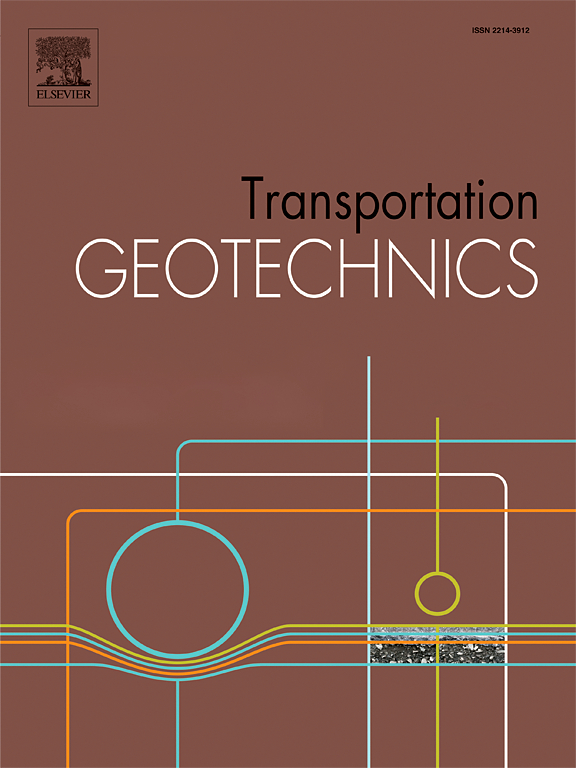断层位错对隧道无砟轨道结构变形与破坏行为的影响
IF 4.9
2区 工程技术
Q1 ENGINEERING, CIVIL
引用次数: 0
摘要
本研究的重点是横贯断裂带的铁路隧道内板状轨道结构的力学行为。将混凝土损伤塑性(CDP)模型与有限元法相结合,建立了板坯轨道-隧道-围岩系统的耦合仿真模型。分析了断层错动对CRTS II型和CRTS III型板状轨道的应力、变形和损伤特征的影响,其中CRTS II型为纵向连接型轨道板,CRTS III型为单元型轨道板。结果表明:在正常断层位错情况下,随着断层位移的增大,轨迹不平整、构造破坏和层间间隙均增大;CRTS II型板式轨道由于结构刚度较高,更容易发生应力集中,从而导致轨道板和底板的损伤更严重,层间间隙更大。其中,CRTS II型板式轨道轨道板的最大损伤变量是CRTS III型板式轨道的16倍,最大层间间隙是CRTS III型板式轨道的1.3倍。相比之下,CRTS III型板式轨道的单元式设计使其对地基变形具有更好的适应性,减轻了应力集中。然而,这种设计导致更多的增加轨道不均匀。CRTS III型板式轨道断层上侧边轨道最大向上弯曲挠度是CRTS II型板式轨道的2倍。逆断层位错作用下,与正断层位错作用相比,压缩作用减少了构造破坏,但变形和层间接触的变化趋势与断层位移的变化趋势保持一致。该研究为跨断裂带隧道内高速铁路轨道的设计和维护提供了有价值的见解。本文章由计算机程序翻译,如有差异,请以英文原文为准。
Effect of fault dislocation on the deformation and damage behavior of ballastless track structures in tunnels
This study focuses on the mechanical behavior of slab track structures within railway tunnels that traverse fault zones. By combining the concrete damaged plasticity (CDP) model with the finite element method, a coupled simulation model of the slab track-tunnel-surrounding rock system has been established. The analysis primarily centers on the effects of fault dislocation on the stress, deformation, and damage characteristics of both CRTS II and CRTS III slab tracks, with the former featuring longitudinally connected track slabs and the latter characterized by unit-type track slabs. The results demonstrate that under normal fault dislocation, track irregularity, structural damage, and the interlayer gap all increase as fault displacement grows. Owing to its relatively higher structural stiffness, the CRTS II slab track is more susceptible to stress concentration, thereby leading to more severe damage to the track slab and base plate, as well as larger interlayer gaps. Specifically, the maximum damage variable of the track slab in the CRTS II slab track is 16 times that of the CRTS III slab track, and its maximum interlayer gap is 1.3 times larger than that of CRTS III slab track. By contrast, the unit-type design of the CRTS III slab track endows it with better adaptability to foundation deformation and mitigates stress concentration. However, this design leads to more increased track irregularity. The maximum upward bending deflection of the rail on the hanging wall side of the fault in the CRTS III slab track is twice as large as that of the CRTS II slab track. Under reverse fault dislocation, compared to normal fault dislocation, the compressive effects reduce structural damage, yet the trends of deformation and interlayer contact remain consistent with the variation of fault displacement. This research offers valuable insights for the design and maintenance of high-speed railway tracks within tunnels that cross fault zones.
求助全文
通过发布文献求助,成功后即可免费获取论文全文。
去求助
来源期刊

Transportation Geotechnics
Social Sciences-Transportation
CiteScore
8.10
自引率
11.30%
发文量
194
审稿时长
51 days
期刊介绍:
Transportation Geotechnics is a journal dedicated to publishing high-quality, theoretical, and applied papers that cover all facets of geotechnics for transportation infrastructure such as roads, highways, railways, underground railways, airfields, and waterways. The journal places a special emphasis on case studies that present original work relevant to the sustainable construction of transportation infrastructure. The scope of topics it addresses includes the geotechnical properties of geomaterials for sustainable and rational design and construction, the behavior of compacted and stabilized geomaterials, the use of geosynthetics and reinforcement in constructed layers and interlayers, ground improvement and slope stability for transportation infrastructures, compaction technology and management, maintenance technology, the impact of climate, embankments for highways and high-speed trains, transition zones, dredging, underwater geotechnics for infrastructure purposes, and the modeling of multi-layered structures and supporting ground under dynamic and repeated loads.
 求助内容:
求助内容: 应助结果提醒方式:
应助结果提醒方式:


